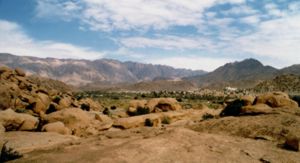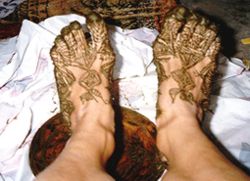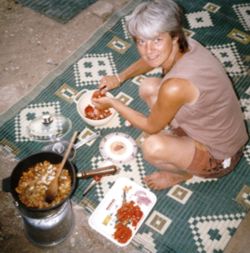
 |

GENERAL
 |
 |
 |

 |
 |
|
 |

 |
 |
|
 |

 |
 |
|
 |

 |
 |
|
 |

 |
 |
|
 |

 |
 |
|
 |

 |
 |
|
 |

 |
 |
|
 |

COMMERCIAL
 |
 |
 |

 |
 |
|
 |

 |
 |
|
 |

INDEPENDENT
 |
 |
 |

 |
 |
|
 |

 |
 |
|
 |

 |
 |
|
 |

 |
 |
|
 |

 |
 |
|
   |
|
 |
Morocco: Travels With Hansi - Part 4
by Cindy Thompson
Tafraoute
Tafraoute is a small town set 1,200 metres up in the Anti-Atlas Mountains in the stunning Ameln Valley, a combination of unusual rock formations, Almond trees and palms. The most memorable part of any visit to Tafraoute, is during sunrise and sun down, when the surrounding rocks and mountains take on a myriad of reds and pinks as the sun rises and sets. Our visit coincided with the annual blossom of the thousands of Almond trees, which are seen throughout the valley. Just outside the village of Tafraoute are an area of huge boulder formations, which can be climbed and give the impression of a land long forgotten. Night fall was just as interesting, given that the skies were crystal clear and devoid of any pollution. Thousands of constellations even the Milky Way could be seen and identified against an inky dark blue background. As my husband and I stood arm in arm, marvelling at the night sky, a shooting star raced across the show of stars before our eyes. Tafraoute had a very relaxed atmosphere, and the local women were very friendly, waving and saying ‘Hello’ to us, as they gathered fire wood to cook their even meal.

Camped next to us was Darren, a New Zealander travelling in a UK registered Land Rover. Darren had been commissioned by a well known car magazine, to make videos and photos of piste roads in Morocco. He must have been a bit cramped in such a small vehicle, but was having a good time. One evening as night fell, it was very cold and we went to say good night and to steal some warmth from Darren’s camp fire. ‘You should make a fire like I have done.’ He chortled. ‘But we have a gas fire in Hansi.’ We replied. As we turned to walk to our camper to retire for the night, we heard a voice mumble, ‘Bastard!’
Back at the free camp near Agadir, where we made some more friends. One of the local beach girls invited me to come to her house and have my feet painted with Henna. Having never been painted with henna, it was an offer I couldn’t refuse. Bushara was a happy young woman in her late 20’s, who was looking for Mr Right amongst the single European travellers, in the hope that he would, like had happened to many of her friends, whisk her off to a land of milk and honey, where she and her new love would live happily ever after. I couldn’t blame her for her actions. She was only trying to move from a life of poverty and despair, which many Moroccans must endure, without any hope of change for the better. There are no social security payments for those out of work and much of the work in the Agadir area is seasonal, due to the tourism. The single European travellers were not complaining, and many had married the Moroccans they had met on previous visits, and were very happy. Bushara’s family were very poor and lived in a very run-down part of town. In fact a shanty town would be a more fitting description, as the ‘houses’ were merely a jumble of breeze blocks with cement haphazardly thrown between them. Each ‘house’ had two or three rooms, with little furniture and no running water and only a precarious supply of electricity. Whilst I was there a 1970’s TV kept going off, prompting Bushara’s brother to fiddle about with the only past-its-best socket, hanging from the middle of the ceiling, which protested with loud bangs, pops and crackles. The house had a squat toilet, which had no door, just a sheet of board as high as your chest. Before the Henna woman arrived, we all sat on the floor around a low table to eat Tarjine, a national Moroccan dish. Tarjine refers more to the way the dish is cooked, rather than the contents, which are usually spiced meat or fish, and vegetables. The Tarjine is an earthenware flat plate, with a conical lid, which slowly cooks the contents over either an open fire or a gas ring. The dish was served in the middle of the table in the Tarjine and we all helped ourselves eating with our fingers, with the aid of flat bread, to tasty pieces of lamb, prunes and veg in a spicy sauce. I was so impressed with the Tarjine that I found out how to use it, and bought one. It is a dish I often cook back in the UK.

A very wrapped up, plump, jovial Henna lady arrived with a bag of interesting things. A bowl, plate, green powder, and a small bottle of clear fluid. She wasted no time in mixing a very messy brown goo with her bare hands, which bared the stains of her trade and were a permanent unsightly dark brown. She then filled a syringe (minus the needle) and started to draw an intricate design of squiggles and lines on my feet. Hours later, I was able to wash the henna goo off. The result was very pleasing and lasted a full month.
The other day there blew a terrible sand storm. Hot winds from the Sahara raged across the camp, carrying with it dust, sand, and rubbish. It was impossible to go outside without getting painfully sand blasted. If you dared to venture outside, sand and dust found its way into your ears, nose, mouth, hair and eyes and inside your clothes. The only thing we could do was sit it out inside Hansi, which although windows and doors were shut tight, didn’t escape a liberal covering of fine dust, which came through every tiny crack possible. Oh for a vacuum cleaner! 
Taroudante is said to be a mini Marakesh and is one of the most elegant towns in Morocco. Enclircled with red ochre wall, it is very well known for jewellery, in particular silver. Whilst in Taroudante we took a tonga ride to the local working tannery. A guide who spoke perfect English was waiting to give us a free tour. Many skins were for sale, including some we would not be able to take back to England, so settled for two large sheep skins for the front seats of Hansi. Tanneries are traditionally placed on the edge of towns or cities close to a good water supply, due to their unclean nature and production of unsavoury odours. In days past, tanneries would be regulated by the seasons, with work being more intensive during the summer months, when skins could be washed and dried easier under the sun. The skins are cured in a potent liquid mixed with cattle urine and pigeon droppings, after which they are subjected to many scrapings, washings, dying, stretchings and eventually drying. The process is such a long and protracted one, that I wondered who first discovered that animal skins could be cured in this way to make leather? Who then discovered the right order in which skins should be cured? I could visualise many early attempts at cracking the code to tanning being thwarted at the last steps, simply due to the tanner forgetting what he had done during the previous weeks, the process being so long. Anomalies aside, Morocco is very well known for its leatherwork, which is of a very high quality.
Taroudante has two main squares, which come alive at dusk. They are a base for the usual snake charmers, story tellers, medicine men and food stalls, which are very popular with the locals who all seem to take their evening walk around the square. One thing I love about ancient, or in Western thinking, Third World countries is the street food. Sadly many tourists miss out on some wonderful treats, because they fear that the food is unsanitised. Which ever country we visit, we always sample the street food, especially stalls that are popular with the locals, on the proviso that if they can eat the food day after day and still survive, so can we. In Taroudante I quickly became addicted to some donuts called Svinge, which were a sort of deep fried Yorkshire pudding, eaten plain, or rolled in cinnamon and sugar. It was fascinating to watch the donut maker scoop the loose wet pastry out of a large bowl by hand, quickly fashion it into a ring, and drop it into a wok of hot oil. A minute later they were hot, puffed up and ready to eat. They were served with a piece of string tied through the hole to facilitate holding and eating. They also came without any health warnings, such as; Careful, this food is hot. The Moroccans, it seemed, accredited members of the public with a little more common sense, than did the Europeans, who feel that they have to produce warnings in writing of dangers that would be obvious to a five year old.
Yes, we liked Morocco and her people. |
 |
|











